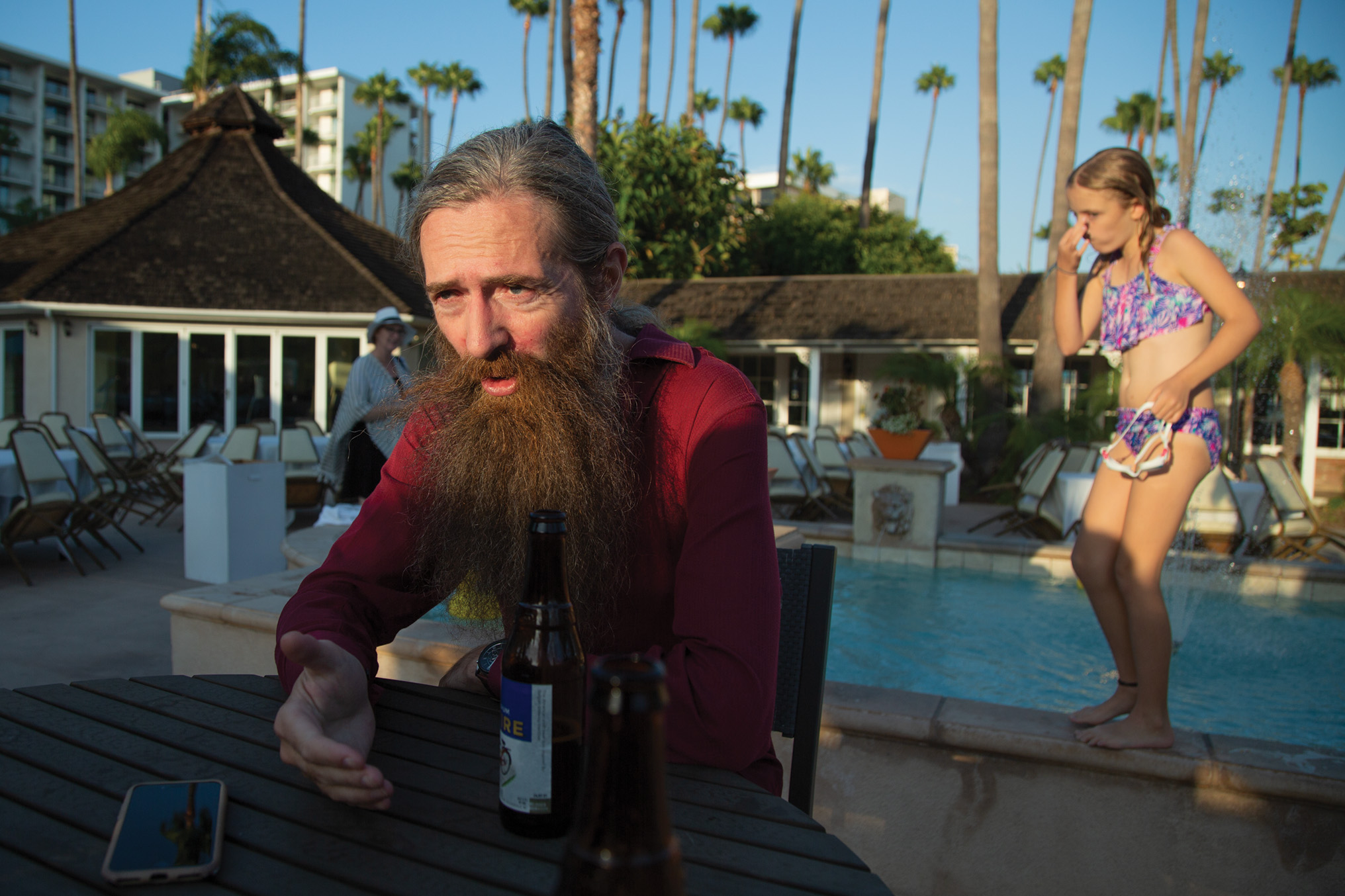This story appears in VICE Magazine's Burnout and Escapism Issue. Click HERE to subscribe.
“Are we ready to open the doors?” an event producer in a skintight catsuit asked into a headset.
As EDM blasted over a PA system, hundreds flooded into the ballroom of San Diego’s Town & Country resort: tanned-and-toned millennials, a group of friends from Venezuela, an engineer from Lagos, Botoxed retirees, and elderly couples pushing Zimmer frames. They took their seats, awaiting the good news:
“No one here, as far as I’m concerned, has to die anymore!” Jim Strole told the crowd to exultant cheers at the third annual RAADfest—the go-to science conference for immortalists of all stripes.
Luminous and dapper, Strole (biologically 70 years old; “ageless” in spirit), has the puffed-chest posture of a circus ringmaster. He was joined by his one-named cohost, Bernadeane (81 in calendar years), wearing a leopard-print pantsuit and red lipstick: “The greatest success, as far as I’m concerned, is not dying!” she added, though that could go without saying in this room.
For almost everyone else, it doesn’t. Most of us grew up surrounded by normative clichés about our mortality: Life is short; death is the only constant; live each day like it’s your last. What does it look like to live life as if there were no end—no such thing as burning out? More than 1,000 people, many of them adherents of Strole and Bernadeane’s Scottsdale, Arizona–based immortalist group, People Unlimited, came to RAADfest to find out.

“I can’t deny there might be some amazing breakthrough tomorrow. I hope it does happen for my own sake and for everybody else too. But I have not seen anything in the scientific literature that suggests that”—and experimental offshore gene therapies don’t count, said Steven Salzberg, a biomedical engineering professor at Johns Hopkins. Salzberg dedicated an article in Forbes to “several rather serious problems” in the claimed success of gene therapies conducted in Colombia on one of RAADfest’s biggest stars, Liz Parrish, the CEO of BioViva, a biotech company. Several times, she took to the stage celebrating the results of an experiment performed only on herself.
A gentleman promoting stem cell therapies in the exhibition hall admitted his field is a “wild west” that includes facilities resembling “eighth grade chemistry labs.” But people like Norman Spivock, a 94-year-old skiing enthusiast, aren’t prepared to rule anything out. “What do we do? Wait around? I don’t have time to wait,” he told me.
Living to 200 may be hard to imagine. The oldest person ever lived to be 122—a spring chicken by People Unlimited standards—and many scientists believe that’s the upper limit of the human life span. But the reality of aging loved ones is something that stares us, and our economies, in the face every day. We’ve been extending life for generations, but vitality hasn’t kept pace.
In the past 200 years, overall human life expectancy has doubled, spurred more by declining infant deaths and improved public health infrastructure than better-managed aging. But the global 85+ cohort is expected to increase 351 percent by 2050, according to a World Health Organization report. Dementia, stroke, or parkinsonism still befall half of women and a third of men during their lifetime, according to research published in October in the Journal of Neurology, Neurosurgery & Psychiatry.
And between the ages of 70 and 90, medical expenses for the elderly increase more than twofold. An American who reaches her 90s will command more than $25,000 per year on average in care costs, much of that going to nursing homes.
While there’s little debate that the enormous burden of aging is a hallmark of our time, it’s mainly regarded as an inevitability by most people and by uber-cautious federal agencies that fund research and green-light drugs.
People Unlimited may represent the outer reaches of optimism around age reversal, but it’s “1,000 times closer to perfection” than the contrary: a perverse acceptance of a tragic status quo, said Aubrey de Grey. The pot-stirring English gerontologist credits himself with shifting the conversation around aging in the 90s, from slowing aging to actually reversing it. “Everyone thought I was crazy,” he told me. Now, as studies trickle out suggesting cell damage reversal may be possible: “Everyone who hates dying loves me.
“When people say, ‘Death gives meaning to life.’ I mean. What. The. Fuck. What is that supposed to mean—you want your mother to get Alzheimer’s?” De Grey is baffled by “the desperation to come up with fucked up crazy reasons to pretend that aging is some kind of blessing in disguise.”
For Bejarano, it’s a conversation she’s never entertained. “I grew up in this life,” the effervescent 31-year-old told me, somewhere between performing a choreographed workout on the RAADfest stage and listening to a talk on stem cell therapies. Now she’s bringing up her one-and-a-half-year-old son to live life like she does: as if there’s no end in sight.
“My motto is, everything I do is to prove myself right—to prove to my body that I’m gonna be here forever,” she said.
Merely believing this is perhaps the ultimate form of mental escapism; but physically, it means treating the body as a vessel of hope straight from the Field of Dreams playbook: If you build it, immortality will come.
Sign up for our newsletter to get the best of VICE delivered to your inbox daily.
from VICE https://ift.tt/2EbT4MP
via cheap web hosting
No comments:
Post a Comment